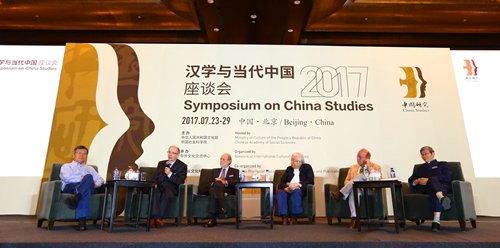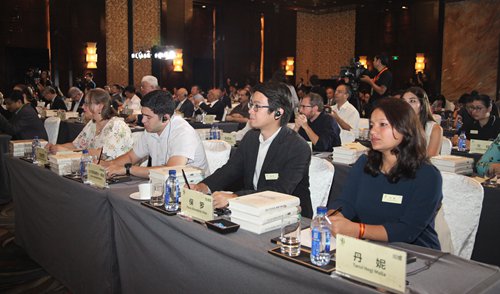

Scholars attend the Symposium on China Studies on Monday. Photos: Courtesy of Network of International Culturalink Entities
Could China's Song Dynasty (960-1279), a period of time often ignored by Western scholars, be considered the world's first Renaissance? Why is food the first thing everyone brings up when talking about China? Was there only one Silk Road…
On Monday and Tuesday, 26 sinologists from 22 countries and regions shared their research in China Studies with 19 Chinese scholars at the fifth Symposium on China Studies in Beijing. The symposium was divided into three sections: Traditional Culture and Contemporary China, Chinese Solutions and Global Governance and Mutual Development and Common Values.
Lectures covered a large range of subjects within these three sections.
"… there can be no doubt that in the visual arts, the Song [Dynasty] was far in advance of artists in Europe, as well as being as revolutionary, in many respects, and indeed more so than European nations," said Colin Christopher Mackenzie, senior curator of East Asian Art at The Nelson-Atkins Museum of Art in the US, concluding that the Song Dynasty has long been underestimated in the West.
Susan L. Beningson, assistant curator of Asian Art at the Brooklyn Museum, lectured on ways to present Chinese history and art to Western audiences.
Ralph Kauz, director of the Department of Sinology at the University of Bonn, shared his research paper on China's Belt and Road initiative: The Significance of Traditional Silk Road Studies for the Modern Belt and Road Initiative: Was There Only One Silk Road?
Kauz pointed to Han Dynasty (206BC-AD220) diplomat Ban Chao's expeditions outside China and Ming Dynasty (1368-1644) explorer Zheng He's expeditionary voyages to Southeast Asia, South Asia, Western Asia and East Africa as proof that the Silk Road was made up of several routes that varied during different time periods.
In addition to the aforementioned sinologists, Chinese scholars presented their thoughts on cultural exchanges between China and the rest of the world, as well as the goal of mutual understanding.
In his lecture "Civilization Began with Eating," Professor Gong Wenxiang from Peking University broke down the structure of four ancient Chinese characters - pao (roast), li (courtesy), xiang (offering), zun (a bronze wine vessel) - to explain how Chinese food is related to Chinese civilization.
To show the importance of food culture and dining in China, he mentioned that when then Chinese premier Zhou Enlai put some food on visiting US President Nixon's plate during a meal, the president seemed "puzzled."
"He didn't know that sharing food with others is a way to show respect in China," he said, going on to note that "in some cases, dining with someone can be invisible public relations 'weapon.'"
As a platform for sharing researches and ideas, the symposium seeks to carry promote sinology research.
"We hope the symposium's theme of 'Global Perspectives for the Belt and Road Initiative' encourages every sinologist to contribute to the theory and practice of the initiative," Xie Jinying, director of the General Bureau for External Cultural Relations at the Ministry of Culture, said on Monday.

